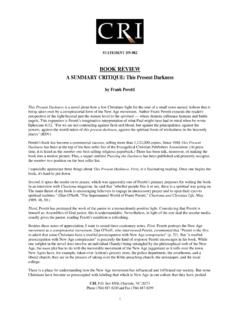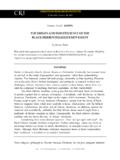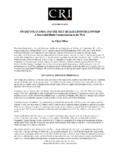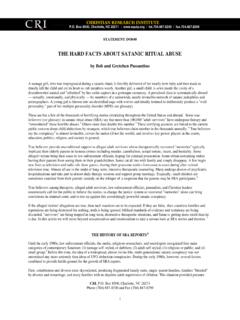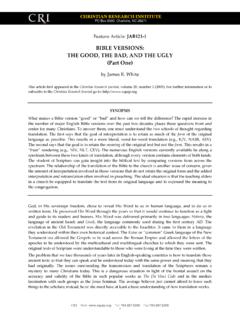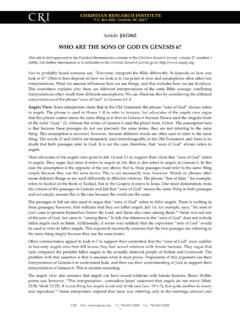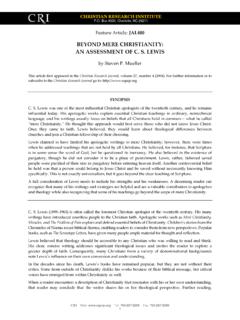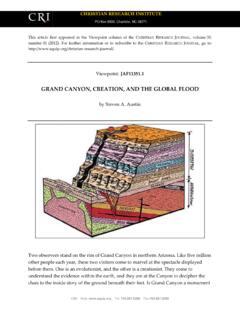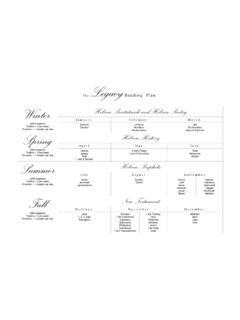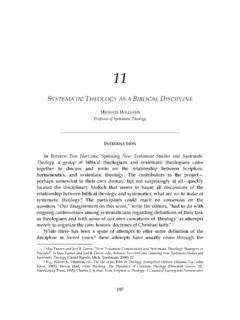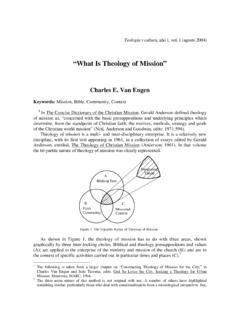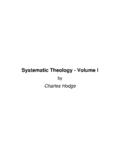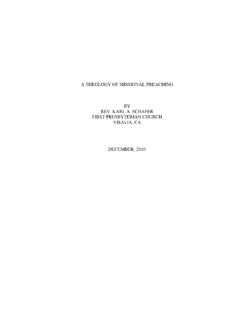Transcription of BLACK THEOLOGY, BLACK POWER, AND THE …
1 STATEMENT DL-100-2. BLACK theology , BLACK power , and the BLACK EXPERIENCE. (Part Two in a Three-Part Series on Liberation theology ). by Ron Rhodes Between 1517 and 1840 it is estimated that twenty million blacks were captured in Africa, transported to America, and brutally enslaved. The experience of these blacks and their descendants serves as the backdrop for understanding contemporary BLACK liberation theology . During slave trading days, blacks were crammed into ships like sardines into a can and brought across the Atlantic. Many died at sea from dysentery, smallpox, and other diseases. "Some starved themselves to death refusing to eat. To prevent this form of suicide, hot coals were applied to the lips to force the slaves to open their mouths to eat."1. Upon arriving on American shores, the slaves men, women, and children were forced to work from sunrise to sunset. Even old and ailing slaves were forced to work. The brutality shown to the slaves is among the saddest chapters in American history.
2 BLACK theologian Anthony Evans tells us that " BLACK women were raped at will by their masters at the threat of death while their husbands could only look on. Families were separated as they were bought and sold like cattle."2. For tax purposes, slaves were counted as property like domestic animals. Eventually, however, a question arose as to how to count slaves in the nation's population. The Congress solved the problem by passing a bill that authorized the Census Bureau to count each slave as three-fifths of a person. This Congressional compromise resulted in what one Negro writer of the 1890s called "the 'Inferior Race Theory,' the placing of the Negro somewhere between the barnyard animals and human beings."3. THE CHRISTIANIZATION OF SLAVERY. Initially, there was heated resistance to evangelizing among slaves. BLACK scholar C. Eric Lincoln tells us there were three principal reasons for this: "(1) the hearing of the gospel required time that could be economically productive.
3 (2) slaves gathered together in a religious assembly might become conscious of their own strength and plot insurrections under cover of religious instruction; (3) there was an English tradition of long standing that once a slave became a Christian he could no longer be held a slave."4. In addition, many whites were repulsed at the suggestion that blacks could go to heaven. Morgan Godwyn, a graduate of Oxford University who served in churches in Virginia around 1665, wrote that slavemasters would commonly exclaim, "What, such as they? What, those BLACK dogs be made Christians? What, shall they be like us?"5. Some whites tried to argue that blacks were less than human. Buckener H. Payne, in his book The Negro: What Is His Ethnological blacks are present with us today, they must have been in the ark. There were only eight souls saved in the ark, however, and they are fully accounted for by Noah's family. As one of the beasts in the ark, the BLACK has no soul to be saved.
4 "6 So why try to evangelize them? CRI, Box 8500, Charlotte, NC 28271. Phone (704) 887-8200 and Fax (704) 887-8299. 1. Regardless of such preposterous arguments, missionary work eventually began among the slaves in the early 1700s and many of them became Christians. The brand of Christianity that was preached to them, however, was one that justified slavery. It was argued that Paul and other New Testament writers issued specific instructions for master- slave relations, thus apparently sanctioning the practice. Moreover, a curse of slavery was placed on the "sons of Ham" (Gen. 9:20-27) who were interpreted to be blacks. Furthermore, slavery was considered a "religious good,". for it amounted to importing unsaved heathens to a Christian land where they could hear the gospel and be saved. (However, though Paul gave instructions on master-slave relations, his underlying belief was that slaves should be freed [1 Cor. 7:21]. Moreover, a curse of slavery was placed only on Ham's son, Canaan whose descendants later occupied Phoenicia and Palestine.)
5 They were Caucasians. As for slavery being a "religious good," this seems an absurd claim in view of the cruel, inhuman treatment shown to the slaves.). Most blacks accepted the slave brand of Christianity at face value. Moreover, white missionaries persuaded the blacks that life on earth was insignificant because "obedient servants of God could expect a reward in heaven after death."7 The white interpretation of Christianity effectively divested the slaves of any concern they might have had about their freedom in the present. As more blacks began attending white Christian churches, restrictions in seating, communion services, and property ownership caused many blacks to seek autonomy in their own congregations and ultimately, separate denominations. So, by the mid-1700s, BLACK slaves had begun meeting in private to worship since authentic worship with whites was impossible. There is sufficient historical evidence to conclude that themes later developed by BLACK liberation theologians were present in these early slave meetings in at least a nascent form.
6 For example, God was interpreted by the slaves as a loving Father who would eventually deliver them from slavery just as He had delivered Israel from Egyptian bondage. Jesus was considered both a Savior and an elder brother who was a fellow sufferer. Heaven had a dual implication for BLACK slaves. Yes, it referred to the future life, but it also came to refer to a state of liberation in the present. Because of the risk involved in preaching liberation, the slave learned how to sing liberation in the very presence of his master: "Swing low, sweet chariot (underground railroad conestoga wagon). Coming for to carry me home (up North to freedom). Swing low (come close to where I am), Sweet chariot Coming for to carry me home. I looked over Jordan (Ohio River border between North and South). And what did I see, Coming for to carry me home A band of angels (northern emancipators with the underground) coming after me. Coming for to carry me home.
7 "8. THE DEVELOPMENT OF BLACK LIBERATIONIST THOUGHT. It was not long before slave theology gave rise to BLACK activism. There are many important figures who contributed to the cause of BLACK liberation throughout BLACK history. We can only mention a few here. Nat Turner (1800-1831) was the most notorious slave preacher who ever lived on American soil. Turner's hatred of slavery propelled him to seek freedom by violence. Indeed, Turner killed nearly sixty white people before being captured and hanged in September, 1831. This violent revolt marked the beginning of the BLACK struggle for liberation. Marcus Garvey (1887-1940) is regarded by many as "the apostle of BLACK theology in the United States of America."9 Martin Luther King, Jr., said Garvey "was the first man on a mass scale and level to give millions of Negroes a sense of dignity and destiny, and make the Negro feel he is somebody."10 Garvey was one of the first to speak of seeing God through BLACK "spectacles.
8 ". CRI, Box 8500, Charlotte, NC 28271. Phone (704) 887-8200 and Fax (704) 887-8299. 2. Howard Thurman, in his book Jesus and the Disinherited (1949), saw BLACK life paralleling Jesus' life because His poverty identified Him with the poor masses. Thurman also noted that Jesus was a member of a minority group (the Jews) in the midst of a larger and controlling dominant group (the Romans). Thurman thus drew many applications for the BLACK experience from the life of Jesus. Martin Luther King, Jr. (1929-1968) was America's most visible civil rights leader from 1955 until his assassination in April, 1968 in Memphis, Tennessee. Though he cannot be called a formal participant in the BLACK theology movement, he nevertheless roused the conscience of BLACK America to passionate commitment to liberation. King was an advocate of Ghandian nonviolent social change. Through nonviolent suffering, King believed that "blacks would not only liberate themselves from the necessity of bitterness and the feeling of inferiority toward whites, but would also prick the conscience of whites and liberate them from a feeling of superiority.
9 "11 To some, King's assassination indicated that nonviolence as a means of liberation had failed and that perhaps a more revolutionary theology was needed. Albert Cleage was one of the more militant BLACK writers of the 1960s. His claim to fame was The BLACK Messiah, a 1968 collection of sermons in which he set forth his brand of BLACK nationalism. Cleage rejected the Pauline books in the New Testament. He said that in contrast to the BLACK Messiah there was a spiritualized Jesus constructed by the apostle Paul who "never knew Jesus and who modified his teaching to conform to the pagan philosophers of the white , as BLACK Christians suffering oppression in a white man's land, do not need the individualistic and other-worldly doctrines of Paul and the white man."12. THE EMERGENCE OF A FORMAL " BLACK theology ". Over one hundred and thirty years after Nat Turner was hanged, BLACK theology emerged as a formal discipline. Beginning with the " BLACK power " movement in 1966, BLACK clergy in many major denominations began to reassess the relationship of the Christian church to the BLACK community.
10 BLACK caucuses developed in the Catholic, Presbyterian, and Episcopal churches. "The central thrust of these new groups was to redefine the meaning and role of the church and religion in the lives of BLACK people. Out of this reexamination has come what some have called a ' BLACK theology .'"13. For the first time in the history of BLACK religious thought, BLACK clergy (primarily educated, middle-class BLACK clergy) and BLACK theologians began to recognize the need for a completely new "starting point" in theology . They insisted that this starting point must be defined by people at the bottom and not the top of the socioeconomic ladder. So, BLACK theologians began to re-read the Bible through the eyes of their slave grandparents and started to speak of God's solidarity with the oppressed of the earth. The most prolific and sophisticated writer of this new theological movement has been James Cone. No one has matched him either in terms of sheer volume of writing, or in terms of the challenge posed by his books.
